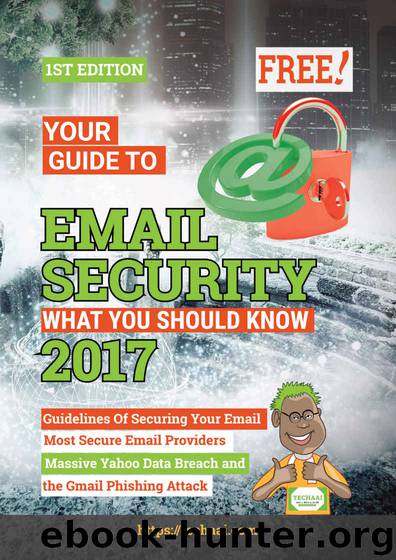Your Guide To Email Security 2017: What You Should Know About Email Security 2017 by Techaai Team & Ekyaku Ruth & Tech Ham

Author:Techaai Team & Ekyaku Ruth & Tech Ham [Team, Techaai]
Language: eng
Format: epub
Publisher: UNKNOWN
Published: 2017-02-15T08:00:00+00:00
CHAPTER 4
Common password mistakes to avoid
The online field is becoming a place where almost everything
requires a password. However, most people take password
security lightly and just use short, easy to remember passwords that
hackers/ intruders can even figure out within seconds.
It is very secure to create
a strong password that
no one can easily guess.
It should be long, difficult
and made up of a
jumbled letters, small,
capital, digits and
symbols.
Here are the common password mistakes that most people make.
1. Personal data
Many people create passwords based on personal information
that’s all too easy to find out. Never use a password that includes
personal details, such as your birthday, your address or the names
of your spouse, pet or children. Using such, gives hackers an easy
clue to figuring out your password and your other passwords for
other accounts.
2. Common passwords
They may be easy to remember but passwords such as ‘123456’ ,
‘abcdefg’, ‘qwerty’, ‘password’, letmein’, ‘and many others that
top the list of the most common passwords people use,
surprisingly, they may be the first passwords even a learner hacker
/ intruder will try. Also, you ought to know that grabbing a
dictionary to choose a password is also an easy way to let in
hackers easily. Hackers can quickly check hundreds of thousands
of entries in seconds using software. Choose a complex, random
password that includes symbols, capitals, lower case, digits and
shot forms.
3. Easy to find
Writing down your password on a sticky note or piece of paper
and keeping it next to your computer is a bad idea it is like leaving
your front door key in the lock. Choose passwords that are
memorable enough that you don’t need to write them down, but
if you must, then keep them in a secure location or use a password
manager.
4. Too short
The shorter your password, the less secure it is. Hackers use
software to crack passwords and the longer it takes, the more
likely they are to give up and move on to easier prey. Each
additional character in your password dramatically increases the
time it takes to crack. So use a password with at least eight
characters, although 12 or 14 characters are better.
Don’t simply add a couple of digits to the end of a password to
lengthen it as hackers expect this.
5. Not complex enough
Avoid using passwords containing all letters or all numbers,
especially if sequential, such as ‘1234abcd’. Make sure your
password includes both upper and lower case letters, numbers
and keyboard symbols. However, avoid common patterns easily
spotted by hackers, such as putting two or four numbers before or
after the letters or adding just one symbol, such as ‘!’, at the end
of the password.
6. Too old
Using the same password for years can be a mistake as someone
may acquire your password and use it to snoop or steal over an
extended period of time. Regularly changing your password
prevents this from happening, however creating a strong but
memorable password each time can be challenge, so consider
using a password manager.
7. One password
Using the same password for multiple accounts poses a security
risk. If a hacker cracks your password, he can then access all your
other accounts that use that same password.
Always use a unique password for each of your online accounts.
Download
This site does not store any files on its server. We only index and link to content provided by other sites. Please contact the content providers to delete copyright contents if any and email us, we'll remove relevant links or contents immediately.
Effective Threat Investigation for SOC Analysts by Yahia Mostafa;(7372)
Practical Memory Forensics by Svetlana Ostrovskaya & Oleg Skulkin(7093)
Machine Learning Security Principles by John Paul Mueller(7059)
Attacking and Exploiting Modern Web Applications by Simone Onofri & Donato Onofri(6718)
Operationalizing Threat Intelligence by Kyle Wilhoit & Joseph Opacki(6703)
Solidity Programming Essentials by Ritesh Modi(4517)
Microsoft 365 Security, Compliance, and Identity Administration by Peter Rising(4100)
Operationalizing Threat Intelligence by Joseph Opacki Kyle Wilhoit(3853)
Learn Computer Forensics - Second Edition by William Oettinger(3594)
Building a Next-Gen SOC with IBM QRadar: Accelerate your security operations and detect cyber threats effectively by Ashish M Kothekar(3563)
Future Crimes by Marc Goodman(3519)
Blockchain Basics by Daniel Drescher(3493)
Mastering Azure Security by Mustafa Toroman and Tom Janetscheck(3470)
Mastering Python for Networking and Security by José Manuel Ortega(3449)
Incident Response with Threat Intelligence by Roberto Martínez(3330)
The Code Book by Simon Singh(3070)
Mastering Bitcoin: Programming the Open Blockchain by Andreas M. Antonopoulos(2980)
Mobile App Reverse Engineering by Abhinav Mishra(2956)
From CIA to APT: An Introduction to Cyber Security by Edward G. Amoroso & Matthew E. Amoroso(2856)
